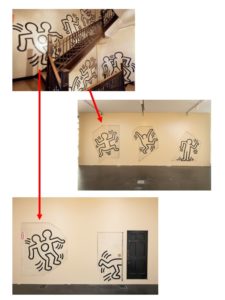In November 2019 I posted a blog about a Keith Haring wall mural in a building used by Grace Church as a center for children and teenagers in New York. The Church sold the building but before doing so had the typically playful Haring figures removed from the three-story stairwell they were originally painted in and sold at auction for just under $4,000,000. I criticized the church for taking this action, which almost surely would have been barred as a mutilation by the moral right provisions of the copyright act had those provisions been adopted when Haring made the childlike figures and had Haring been alive when the mural was mutilated. A church, of all institutions, should have been morally scrupulous in treating a famous artist’s work, especially one as wonderful and playful as this one.
The buyer at the auction has remained anonymous, but the figures unceremoniously carved out of the Grace Building walls have now reappeared at an exhibition at the Denver Museum of Contemporary Art that opened on February 26 and will continue on view until August 22, 2021.[1] Though the auction purchaser has carefully preserved the figures cut from the stairwell, the museum display confirms the validity of my initial concern. The figures lack the coherence they joyfully displayed in their original setting as they playfully climbed up the three story stairwell. While the figures on display in Denver certainly are recognizably Haring’s work and retain some of his childlike playfulness, the unity and joy of the original mural has been lost. As Ray Mark Rinaldi, who reviewed the Denver exhibition for the New York Times, recently wrote, the figures are, “sliced and diced and a bit worse for wear, but are still * * * prime examples of an important painter’s work. * * * Still, the display has its limitations. * * * [V]iewers strolling through the exhibition’s four rooms can’t help but feel they are looking not at the original Grace House mural, but a chop-shop version of it. Removing this work from a stairwell fatally obscures its narrative of climbing stairs. The story is lost.”[2] And so it is, as a few images from the original and Denver settings make clear.
The top image is a view of the original Haring mural in place. The next two are from the Denver exhibition. Each of the exhibition images is visible in the original setting, but now severed from the stairwell scene. The exhibition really is an artistic “crime scene.” The only way these delightful creations can be displayed in a responsible way is to rebuild the three story stairwell and place the drawings in their proper locations. I wish the Denver museum had done that, but I suspect they don’t have a place to do that. Unfortunately there are very few museums with a display space large enough to hold such an installation. Perhaps the main atrium at the Museum of Modern Art in New York could hold it. Even that would probably be inadequate to display the “story” as it once appeared in the confined stairwell of the Grace Building.

[1] Keith Haring: Grace House Mural, MCA Denver, https://mcadenver.org/exhibitions/keith-haring (last visited July 15, 2021).
[2] Ray Mark Rinaldi, Reconnecting With Keith Haring’s Grace House Mural (in 13 Pieces), The New York Times (July 14, 2021),https://www.nytimes.com/2021/07/14/arts/design/keith-haring-grace-house-mural-denver.html (last visited July 15,2021).

